Sample-return mission

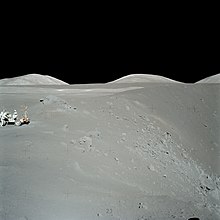
A sample-return mission is a spacecraft mission to collect and return samples from an extraterrestrial location to Earth for analysis. Sample-return missions may bring back merely atoms and molecules or a deposit of complex compounds such as loose material ("soil") and rocks. These samples may be obtained in a number of ways, such as soil and rock excavation or a collector array used for capturing particles of solar wind or cometary debris.
To date, samples of Moon rock from Earth's Moon have been collected by robotic and crewed missions, the comet Wild 2 and the asteroids 25143 Itokawa and 162173 Ryugu have been visited by robotic spacecraft which returned samples to Earth, and samples of the solar wind have been returned by the robotic Genesis mission. Samples from the asteroid 101955 Bennu are en route back to Earth and are expected to arrive in September 2023.
In addition to sample-return missions, samples from three identified non-terrestrial bodies have been collected by means other than sample-return missions: samples from the Moon in the form of Lunar meteorites, samples from Mars in the form of Martian meteorites, and samples from Vesta in the form of HED meteorites.
Scientific use[]



Samples available on Earth can be analyzed in laboratories, so we can further our understanding and knowledge as part of the discovery and exploration of the Solar System. Until now, many important scientific discoveries about the Solar System were made remotely with telescopes, and some Solar System bodies were visited by orbiting or even landing spacecraft with instruments capable of remote sensing or sample analysis. While such an investigation of the Solar System is technically easier than a sample-return mission, the scientific tools available on Earth to study such samples are far more advanced and diverse than those that can go on spacecraft. Further, analysis of samples on Earth allows follow up of any findings with different tools, including tools that can tell intrinsic extraterrestrial material from terrestrial contamination,[2] and those that have yet to be developed; in contrast, a spacecraft can carry only a limited set of analytic tools, and these have to be chosen and built long before launch.
Samples analyzed on Earth can be matched against findings of remote sensing for more insight into the processes that formed the Solar System. This was done, for example, with findings by the Dawn spacecraft, which visited the asteroid Vesta from 2011 to 2012 for imaging, and samples from HED meteorites (collected on Earth until then), which were compared to data gathered by Dawn.[3] These meteorites could then be identified as material ejected from the large impact crater Rheasilvia on Vesta. This allowed deducing the composition of the crust, mantle and core of Vesta. Similarly, some differences in the composition of asteroids (and, to a lesser extent, different compositions of comets) can be discerned by imaging alone. However, for a more precise inventory of the material on these different bodies, more samples will be collected and returned in the future, to match their compositions with the data gathered through telescopes and astronomical spectroscopy.
One further focus of such investigation—besides the basic composition and geologic history of the various Solar System bodies—is the presence of the building blocks of life on comets, asteroids, Mars or the moons of the gas giants. Several sample-return missions to asteroids and comets are currently in the works. More samples from asteroids and comets will help determine whether life formed in space and was carried to Earth by meteorites. Another question under investigation is whether extraterrestrial life formed on other Solar System bodies like Mars or on the moons of the gas giants, and whether life might even exist there. The result of NASA's last "Decadal Survey" was to prioritize a Mars sample-return mission, as Mars has a special importance: it is comparatively "nearby", might have harbored life in the past, and might even continue to sustain life. Jupiter's moon Europa is another important focus in the search for life in the Solar System. However, due to the distance and other constraints, Europa might not be the target of a sample-return mission in the foreseeable future.
Planetary protection[]
Planetary protection aims to prevent biological contamination of both the target celestial body and the Earth in the case of sample-return missions. A sample return from Mars or other location with the potential to host life is a category V mission under COSPAR, which directs to the containment of any unsterilized sample returned to Earth. This is because it is unknown what the effects such hypothetical life would be on humans or the biosphere of Earth.[4] For this reason, Carl Sagan and Joshua Lederberg argued in the 1970s that we should do sample-return missions classified as category V missions with extreme caution, and later studies by the NRC and ESF agreed.[4][5][6][7][8]
Sample-return missions[]
First missions[]
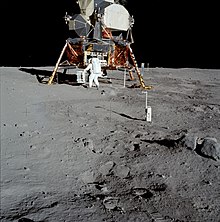


The Apollo program returned over 382 kg (842 lb) of lunar rocks and regolith (including lunar 'soil') to the Lunar Receiving Laboratory in Houston.[9][10][11] Today, 75% of the samples are stored at the Lunar Sample Laboratory Facility built in 1979.[12] In July 1969, Apollo 11 achieved the first successful sample return from another Solar System body. It returned approximately 22 kilograms (49 lb) of Lunar surface material. This was followed by 34 kilograms (75 lb) of material and Surveyor 3 parts from Apollo 12, 42.8 kilograms (94 lb) of material from Apollo 14, 76.7 kilograms (169 lb) of material from Apollo 15, 94.3 kilograms (208 lb) of material from Apollo 16, and 110.4 kilograms (243 lb) of material from Apollo 17.[citation needed]
One of the most significant advances in sample-return missions occurred in 1970 when the robotic Soviet mission known as Luna 16 successfully returned 101 grams (3.6 oz) of lunar soil. Likewise, Luna 20 returned 55 grams (1.9 oz) in 1974, and Luna 24 returned 170 grams (6.0 oz) in 1976. Although they recovered far less than the Apollo missions, they did this fully automatically. Apart from these three successes, other attempts under the Luna programme failed. The first two missions were intended to outstrip Apollo 11 and were undertaken shortly before them in June and July 1969: Luna E-8-5 No. 402 failed at start, and Luna 15 crashed on the Moon. Later, other sample-return missions failed: Kosmos 300 and Kosmos 305 in 1969, Luna E-8-5 No. 405 in 1970, Luna E-8-5M No. 412 in 1975 had unsuccessful launches, and Luna 18 in 1971 and Luna 23 in 1974 had unsuccessful landings on the Moon.[13]
In 1970, the Soviet Union planned for a 1975 first Martian sample-return mission in the Mars 5NM project. This mission was planned to use an N1 rocket, but as this rocket never flew successfully, the mission evolved into the Mars 5M project, which would use a double launch with the smaller Proton rocket and an assembly at a Salyut space station. This Mars 5M mission was planned for 1979, but was canceled in 1977 due to technical problems and complexity; all hardware was ordered destroyed.[14]
1990s[]
The Orbital Debris Collection (ODC) experiment deployed on the Mir space station for 18 months in 1996–97 used aerogel to capture particles from low Earth orbit, including both interplanetary dust and man-made particles.[15]
2000s[]
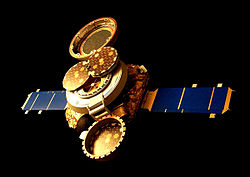
The next mission to return extraterrestrial samples was the Genesis mission, which returned solar wind samples to Earth from beyond Earth orbit in 2004. Unfortunately, the Genesis capsule failed to open its parachute while re-entering the Earth's atmosphere and crash-landed in the Utah desert. There were fears of severe contamination or even total mission loss, but scientists managed to save many of the samples. They were the first to be collected from beyond lunar orbit. Genesis used a collector array made of wafers of ultra-pure silicon, gold, sapphire, and diamond. Each different wafer was used to collect a different part of the solar wind.[citation needed]

Genesis was followed by NASA's Stardust spacecraft, which returned comet samples to Earth on January 15, 2006. It safely passed by Comet Wild 2 and collected dust samples from the comet's coma while imaging the comet's nucleus. Stardust used a collector array made of low-density aerogel (99% of which is space), which has about 1/1000 of the density of glass. This enables the collection of cometary particles without damaging them due to high impact velocities. Particle collisions with even slightly porous solid collectors would result in the destruction of those particles and damage to the collection apparatus. During the cruise, the array collected at least seven interstellar dust particles.[16]
2010s and 2020s[]
In June 2010 the Japan Aerospace Exploration Agency (JAXA) Hayabusa probe returned asteroid samples to Earth after a rendezvous with (and a landing on) S-type asteroid 25143 Itokawa. In November 2010, scientists at the agency confirmed that, despite failure of the sampling device, the probe retrieved micrograms of dust from the asteroid, the first brought back to Earth in pristine condition.[17]
The Russian Fobos-Grunt was a failed sample-return mission designed to return samples from Phobos, one of the moons of Mars. It was launched on November 8, 2011, but failed to leave Earth orbit and crashed after several weeks into the southern Pacific Ocean.[18][19]
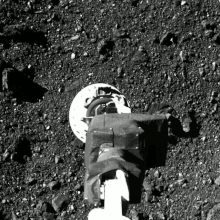
— (Full-sized image)
The Japan Aerospace Exploration Agency (JAXA) launched the improved Hayabusa2 space probe on December 3, 2014. Hayabusa2 arrived at the target near-Earth C-type asteroid 162173 Ryugu (previously designated 1999 JU3) on 27 June 2018.[20] It surveyed the asteroid for a year and a half and took samples. It left the asteroid in November 2019[21][22] and returned to Earth on December 6, 2020.[23]
The OSIRIS-REx mission was launched in September 2016 on a mission to return samples from the asteroid 101955 Bennu.[24][25] The samples are expected to enable scientists to learn more about the time before the birth of the Solar System, initial stages of planet formation, and the source of organic compounds that led to the formation of life.[26] It reached the proximity of Bennu on 3 December 2018,[27] where it began analyzing its surface for a target sample area over the next several months. It collected its sample on 20 October 2020,[28][29] and is expected to return to Earth on 24 September 2023.[30][31]
China launched the Chang'e 5 lunar sample return mission on November 23, 2020, which returned to Earth with 2 kilograms of lunar soil on December 16, 2020.[32] It was first lunar sample return in over 40 years.[33]
Future missions[]

Russia has plans for Luna-Glob missions to return samples from the Moon by 2027 and Mars-Grunt to return samples from Mars in the late 2020s.
JAXA is developing the MMX mission, a sample-return mission to Phobos that will be launched in 2024.[35] MMX will study both moons of Mars, but the landing and the sample collection will be on Phobos. This selection was made because of the two moons, Phobos's orbit is closer to Mars and its surface may have particles blasted from Mars. Thus the sample may contain material originating on Mars itself.[36] A propulsion module carrying the sample is expected to return to Earth in approximately September 2029.[37]
China will launch the Chang'e 6 lunar sample return mission in 2023.
China has plans for a Mars sample return mission by 2030.[38][39] Also, the Chinese Space Agency is designing a sample-retrieval mission from Ceres that would take place during the 2020s.[40]
NASA has long planned a Martian sample-return mission,[41] but has yet to secure the budget to successfully design, build, launch, and land such a probe. The mission remained on NASA's roadmap for planetary science as of the 2013 Planetary Science Decadal Survey.[42] The Perseverance rover, launched in 2020, will collect drill core samples and stash them on Mars' surface by 2023.[43] A joint NASA-ESA mission to return them is planned for the late twenties, consisting of a lander to retrieve the samples and raise them into orbit, and an orbiter to return them to Earth.[44]
Comet sample-return missions continue to be a NASA priority. Comet Surface Sample Return was one of the six themes for proposals for NASA's fourth New Frontiers mission in 2017.[45]
Methods of sample return[]

Sample-return methods include, but are not restricted to the following:
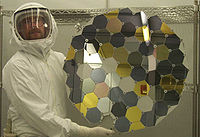
Collector array[]
A collector array may be used to collect millions or billions of atoms, molecules, and fine particulates by using wafers made of different elements. The molecular structure of these wafers allows the collection of various sizes of particles. Collector arrays, such as those flown on Genesis, are ultra-pure in order to ensure maximal collection efficiency, durability, and analytical distinguishability.
Collector arrays are useful for collecting tiny, fast-moving atoms such as those expelled by the Sun through the solar wind, but can also be used for collection of larger particles such as those found in the coma of a comet. The NASA spacecraft known as Stardust implemented this technique. However, due to the high speeds and size of the particles that make up the coma and the area nearby, a dense solid-state collector array was not viable. As a result, another means for collecting samples had to be designed to preserve the safety of the spacecraft and the samples themselves.
Aerogel[]
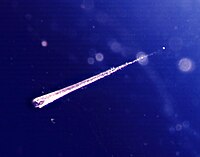
Aerogel is a silica-based porous solid with a sponge-like structure, 99.8% of whose volume is empty space. Aerogel has about 1/1000 of the density of glass. An aerogel was used in the Stardust spacecraft because the dust particles the spacecraft was to collect would have an impact speed of about 6 km/s.[46] A collision with a dense solid at that speed could alter their chemical composition or perhaps vaporize them completely.
Since the aerogel is mostly transparent, and the particles leave a carrot-shaped path once they penetrate the surface, scientists can easily find and retrieve them. Since its pores are on the nanometer scale, particles, even ones smaller than a grain of sand, do not merely pass through the aerogel completely. Instead, they slow to a stop and then are embedded within it. The Stardust spacecraft has a tennis-racket-shaped collector with aerogel fitted to it. The collector is retracted into its capsule for safe storage and delivery back to Earth. Aerogel is quite strong and easily survives both launching and outer-space environments.
Robotic excavation and return[]
Some of the riskiest and most difficult types of sample-return missions are those that require landing on an extraterrestrial body such as an asteroid, moon, or planet. It takes a great deal of time, money, and technical ability to even initiate such plans. It is a difficult feat that requires that everything from launch to landing to retrieval and launch back to Earth is planned out with high precision and accuracy.
This type of sample return, although having the most risks, is the most rewarding for planetary science. Furthermore, such missions carry a great deal of public outreach potential, which is an important attribute for space exploration when it comes to public support. The only successful robotic sample-return missions of this type have been the Soviet Luna landers and Chinese Chang'e 5.[citation needed]
List of missions[]
Crewed missions[]
| Launch date | Operator | Name | Sample origin | Samples returned | Recovery date | Mission result |
|---|---|---|---|---|---|---|
| 16 July 1969 | Apollo 11 | Moon | 22 kilograms (49 lb) | 24 July 1969 | Successful | |
| 14 November 1969 | Apollo 12 | Moon | 34 kilograms (75 lb) and Surveyor 3 parts[note 1][47] | 24 November 1969 | Successful | |
| 11 April 1970 | Apollo 13 | Moon | — | 17 April 1970 | Failed | |
| 31 January 1971 | Apollo 14 | Moon | 43 kilograms (95 lb) | 9 February 1971 | Successful | |
| 26 July 1971 | Apollo 15 | Moon | 77 kilograms (170 lb) | 7 August 1971 | Successful | |
| 16 April 1972 | Apollo 16 | Moon | 95 kilograms (209 lb) | 27 April 1972 | Successful | |
| 7 December 1972 | Apollo 17 | Moon | 111 kilograms (245 lb) | 19 December 1972 | Successful | |
| 22 March 1996 | Earth-Orbital Debris Collection | Low Earth orbit | Particles | 6 October 1997 | Successful[48] | |
| 14 April 2015 | Tanpopo mission | Low Earth orbit | Particles | February 2018[49] | Successful |
Robotic missions[]
| Launch date | Operator | Name | Sample origin | Samples returned | Recovery date | Mission result |
|---|---|---|---|---|---|---|
| 14 June 1969 | Luna E-8-5 No. 402 | Moon | Failure | |||
| 13 July 1969 | Luna 15 | Moon | Failure | |||
| 23 September 1969 | Kosmos 300 | Moon | Failure | |||
| 22 October 1969 | Kosmos 305 | Moon | Failure | |||
| 6 February 1970[13] | Luna E-8-5 No. 405 | Moon | Failure | |||
| 12 September 1970 | Luna 16 | Moon | 101 grams (3.6 oz) | 24 September 1970 | Success | |
| 2 September 1971 | Luna 18 | Moon | Failure | |||
| 14 February 1972 | Luna 20 | Moon | 55 grams (1.9 oz) | 25 February 1972 | Success | |
| 2 November 1974 | Luna 23 | Moon | Failure | |||
| 16 October 1975 | Luna E-8-5M No. 412 | Moon | Failure | |||
| 9 August 1976 | Luna 24 | Moon | 170 grams (6.0 oz) | 22 August 1976 | Success | |
| 7 February 1999 | Stardust | 81P/Wild | Particles, weighing approx 1 gram (0.035 oz) | 15 January 2006 | Success | |
| 8 August 2001 | Genesis | Solar wind | Particles | 9 September 2004 | Success (partial) | |
| 9 May 2003 | Hayabusa | 25143 Itokawa | Particles, weighing less than 1 gram (0.035 oz) | 13 June 2010 | Success (partial) | |
| 8 November 2011 | Fobos-Grunt | Phobos | Failure | |||
| 3 December 2014 | Hayabusa2 | 162173 Ryugu | 5.4 grams (0.19 oz)[50] (including gas samples) | 6 December 2020 | Success | |
| 8 September 2016 | OSIRIS-REx | 101955 Bennu | 24 September 2023 | Ongoing | ||
| 23 November 2020 | Chang'e 5 | Moon | 1,731 grams (61.1 oz) | 16 December 2020 | Success | |
| 2023 | Chang'e 6 | Moon | 2023 | Planned | ||
| 2024 | MMX | Phobos | 2029 | Planned | ||
| 2026 | unnamed | Mars | [note 2] |
2031 | Ongoing[note 3] |
See also[]
- Asteroid mining
- Exploration of Mars
- Exploration of the Moon
- Extraterrestrial sample curation
- List of lunar probes
- Robotic exploration of the Moon
- Timeline of Solar System exploration
Notes[]
- ^ The Apollo 12 astronauts removed several components from Surveyor 3, including the television camera, and returned them to Earth, where they are treated as lunar samples by NASA. It returned about 10 kilograms (22 lb) of the Surveyor 3's original landing mass of 302 kilograms (666 lb) to Earth to study the effects of long term exposure. Surveyor 3 is the only probe visited by humans on another world.
- ^ The Perseverance rover is gathering samples for eventual return to Earth. It has so far gathered one atmospheric (gas) sample.[51]
- ^ NASA's and the ESA's are still in the planning stages.
References[]
- ^ Amos, Jonathan (January 31, 2016). "Hunt for Antarctica's 'lost meteorites'". BBC News. Retrieved January 15, 2018.
- ^ Chan, Queenie Hoi Shan; Stroud, Rhonda; Martins, Zita; Yabuta, Hikaru (12 May 2020). "Concerns of Organic Contamination for Sample Return Space Missions". Space Science Reviews. 216 (4): 56. doi:10.1007/s11214-020-00678-7. PMC 7319412. PMID 32624626.
- ^ What did Dawn learn at Vesta? The Planetary Society.
- ^ Jump up to: a b Joshua Lederberg Parasites Face a Perpetual Dilemma (PDF). Volume 65, Number 2, 1999 / American Society for Microbiology News 77.
- ^ Assessment of Planetary Protection Requirements for Mars Sample Return Missions (Report). National Research Council. 2009.
- ^ Preliminary Planning for an International Mars Sample Return Mission Report of the International Mars Architecture for the Return of Samples (iMARS) Working Group June 1, 2008.
- ^ European Science Foundation – Mars Sample Return backward contamination – Strategic advice and requirements Archived 2016-06-02 at the Wayback Machine July, 2012, ISBN 978-2-918428-67-1 – see Back Planetary Protection section. (for more details of the document see abstract).
- ^ Mars Sample Return: Issues and Recommendations. Task Group on Issues in Sample Return. National Academies Press, Washington, DC (1997).
- ^ "NASA Lunar Sample Laboatory Facility". NASA Curation Lunar. NASA. September 1, 2016. Retrieved February 15, 2017.
A total of 382 kilograms of lunar material, comprising 2200 individual specimens returned from the Moon...
- ^ Orloff 2004, "Extravehicular Activity"
- ^ Chaikin, Andrew (2007). A Man On the Moon: The Voyages of the Apollo Astronauts (Third ed.). New York: Penguin Books. pp. 611–613.
- ^ Kristen Erickson (July 16, 2009). Amiko Kauderer (ed.). "Rock Solid: JSC's Lunar Sample Lab Turns 30". 40th Anniversary of Apollo Program. NASA. Retrieved June 29, 2012.
- ^ Jump up to: a b Wade, Mark. "Luna Ye-8-5". Encyclopedia Astronautica. Retrieved 27 July 2010.
- ^ Советский грунт с Марса (in Russian) Archived April 8, 2010, at the Wayback Machine
- ^ "Orbital Debris Collector (ODC)". NASA. July 16, 1999. Archived from the original on May 21, 2021. Retrieved 7 April 2021.
- ^ Westphal, A.; Stroud, R.; et al. (15 Aug 2014). "Evidence for interstellar origin of seven dust particles collected by the Stardust spacecraft". Science. 345 (6198): 786–91. Bibcode:2014Sci...345..786W. doi:10.1126/science.1252496. hdl:2381/32470. PMID 25124433. S2CID 206556225.
- ^ Amos, Jonathan (November 16, 2010). "Japan probe collected particles from Itokawa asteroid". BBC News. Retrieved November 16, 2010.
- ^ Emily Lakdawalla (January 13, 2012). "Bruce Betts: Reflections on Phobos LIFE". The Planetary Society Blog. Retrieved March 17, 2012.
- ^ Kramer, Andrew (January 15, 2012). "Russia's Failed Mars Probe Crashes Into Pacific". Retrieved January 16, 2012.
- ^ "Japanese spacecraft reaches asteroid after three-and-a-half-year journey – Spaceflight Now". spaceflightnow.com. Retrieved 2018-09-23.
- ^ Bartels, Meghan (2019-11-13). "Farewell, Ryugu! Japan's Hayabusa2 Probe Leaves Asteroid for Journey Home". Space.com.
- ^ "Joint Statement for Cooperation in the Hayabusa2 Sample Return Mission by the Australian Space Agency and the Japan Aerospace Exploration Agency" (Press release). JAXA. July 14, 2020. Retrieved July 14, 2020.
- ^ Asteroid capsule located in Australian desert
- ^ "NASA's OSIRIS-REx Speeds Toward Asteroid Rendezvous". NASA. 9 September 2016. Retrieved 9 September 2016.
- ^ "Asteroid probe begins seven-year quest". BBC News. 9 September 2016. Retrieved 9 September 2016.
- ^ "NASA To Launch New Science Mission To Asteroid In 2016". NASA.
- ^ Chang, Kenneth (3 December 2018). "NASA's Osiris-Rex Arrives at Asteroid Bennu After a Two-Year Journey". The New York Times. Retrieved 3 December 2018.
- ^ Potter, Sean (2020-10-20). "NASA's OSIRIS-REx Spacecraft Successfully Touches Asteroid". NASA. Retrieved 2020-10-21.
- ^ "NASA's OSIRIS-REx Successfully Stows Sample of Asteroid Bennu". OSIRIS-REx Mission. Retrieved 2020-11-29.
- ^ Chang, Kenneth (10 May 2021). "Bye-Bye, Bennu: NASA Heads Back to Earth With Asteroid Stash in Tow - The OSIRIS-REX mission will spend two years cruising home with space rock samples that could unlock secrets of the early solar system". The New York Times. Retrieved 11 May 2021.
- ^ "OSIRIS-REx Factsheet" (PDF). NASA/Explorers and Heliophysics Projects Division. August 2011.
- ^ "China recovers Chang'e-5 moon samples after complex 23-day mission". SpaceNews. 2020-12-16. Retrieved 2020-12-16.
- ^ Jones, Andrew (November 28, 2020). "China's Chang'e 5 enters lunar orbit for historic attempt to return moon samples". Space.com. Retrieved 2020-11-29.
- ^ "Archived copy" (PDF). Archived from the original (PDF) on 2016-12-22. Retrieved 2017-12-29.CS1 maint: archived copy as title (link)
- ^ "Martian Moons eXploration (MMX) Mission Overview" (PDF). JAXA Tokyo Office: JAXA. 10 April 2017. Retrieved 2018-07-20.
- ^ 火星衛星の砂回収へ JAXA「フォボス」に探査機. Nikkei (in Japanese). September 22, 2017. Retrieved 2018-07-20.
- ^ Atkinson, Nancy (20 February 2020). "Japan Is Sending a Lander to Phobos". Universe Today. Retrieved 7 March 2020.
- ^ English.news.cn (2012-10-10). "China considers more Mars probes before 2030". news.xinhuanet.com. Retrieved 2012-10-14.
- ^ Staff Writers Beijing (AFP) (2012-10-10). "China to collect samples from Mars by 2030: Xinhua". marsdaily.com. Retrieved 2012-10-14.
- ^ China's Deep-space Exploration to 2030 by Zou Yongliao Li Wei Ouyang Ziyuan Key Laboratory of Lunar and Deep Space Exploration, National Astronomical Observatories, Chinese Academy of Sciences, Beijing.
- ^ Chang, Kenneth (28 July 2020). "Bringing Mars Rocks to Earth: Our Greatest Interplanetary Circus Act - NASA and the European Space Agency plan to toss rocks from one spacecraft to another before the samples finally land on Earth in 2031". The New York Times. Retrieved 28 July 2020.
- ^ Visions and Voyages for Planetary Science in the Decade 2013–2022, National Academies Press.
- ^ Voosen, Paul (25 June 2020). "NASA's new rover will collect martian rocks—and clues to planet's ancient climate". Science. American Association for the Advancement of Science. doi:10.1126/science.abd5006. Retrieved 12 October 2020.
- ^ Potter, Sean (2020-12-17). "NASA Moves Forward with Campaign to Return Mars Samples to Earth". NASA. Retrieved 2021-07-16.
- ^ Keeter, Bill (5 May 2017). "NASA Receives Proposals for Future Solar System Mission". NASA News. Retrieved 2017-09-20.
- ^ "Stardust, NASA's Comet Sample Return Mission". NASA. Retrieved 11 December 2015.
- ^ "Surveyor 2 parts brought by Apollo 12". www.collectspace.com.
- ^ "Mir Orbital Debris Collector Data Analyzed". Spacedaily.com. Retrieved 8 July 2018.
- ^ "NASA - Astrobiology Exposure and Micrometeoroid Capture Experiments". www.nasagov.com.
- ^ "小惑星探査機「はやぶさ2」が採取した小惑星Ryugu(リュウグウ)サンプルは約5.4グラム" (in Japanese). December 18, 2020. Retrieved 2020-12-18.
- ^ mars.nasa.gov. "NASA's Perseverance Plans Next Sample Attempt". NASA’s Mars Exploration Program. Retrieved 2021-08-27.
External links[]
- Mars Exploration: Sample Returns Jet Propulsion Laboratory Mars Exploration Program on sample return missions.
- Stardust Homepage Jet Propulsion Laboratory Stardust mission website.
- Genesis Mission Homepage Jet Propulsion Laboratory Genesis mission website.
- Stardust: Aerogel Stardust website on aerogel technology.
- JAXA Hayabusa JAXA Hayabusa project update.
- MarsNews.com: Mars Sample Return MarsNews.com on Mars Sample Return missions.
- Texas Space Grant Consortium: Missions to the Moon A list of missions to the Moon from 1958 to 1998.
- Evaluating the Biological Potential in Samples Returned from Planetary Satellites and Small Solar System Bodies The National Academies, Space Science Board 1998
- Discovery and exploration of the Solar System
- Sample return missions
- Spaceflight
- Spaceflight timelines
